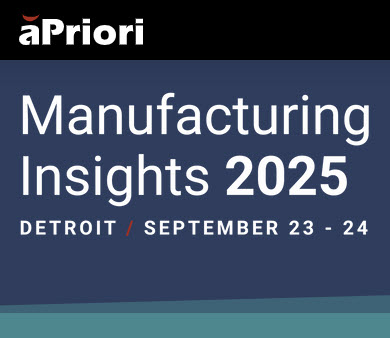October 8, 2025
The Need for Speed

Transcript
The Manufacturing Metamorphosis: How Digitalization and AI Are Transforming Product Development
The manufacturing industry is undergoing a historic metamorphosis. What began with digital transformation is now accelerating through artificial intelligence. And it’s happening at exactly the right time. Over the next five years, McKinsey estimates that $30 trillion in corporate revenue will depend on products that haven’t yet reached the market.
In this high-stakes environment, competition is fierce, global supply chains are unstable, and the drive to innovate faster than ever before is reshaping how we design, manufacture, and deliver products.
The Pressure to Be First
Across the globe, manufacturers are racing to bring new products to market. But the drive for speed often comes at a cost. The pressure doesn’t fall solely on design engineering teams—it cascades downstream to procurement, manufacturing, and supply chain operations.
Too often, these teams are left scrambling to solve last-minute issues, “putting out fires” to ensure products can be launched on time. The result is predictable: costly inefficiencies and missed opportunities.
We recently worked with a company that rushed a new platform to market—only to discover a $150 million cost overrun after launch. By that point, 70–80% of costs were already locked in. That money was no longer available for innovation or growth. Compounding the issue, as much as 25% of engineering time was consumed fixing problems from previous releases.
The lesson is clear: speed alone isn’t enough. The winning companies are the ones that build quality, manufacturability, and cost efficiency into the design phase—well before production begins.
Building Cross-Functional Collaboration Early
Our most successful customers today are those who mitigate design and manufacturability issues early in product development. They foster collaboration between design, manufacturing, and procurement from the start.
Rich Morabito—formerly of Rivian and Nikola, now at Slate—shared a compelling presentation on how his teams used aPriori data to unify engineering and manufacturing. The result: faster launches, fewer surprises, and significant cost savings.
We’ve all heard the traditional design mantra—form, fit, function, and quality. But today, those aren’t enough. Manufacturers must also consider supply chain risk, geopolitical disruption, and financial volatility from the outset.
Supply Chain Volatility and the Need for Agility
Every manufacturer today faces the same external pressures: tariffs, raw material shortages, component delays, and suppliers going out of business. Add to that the macroeconomic volatility of politics, war, inflation, and fluctuating interest rates, and the need for agility becomes non-negotiable.
To survive—and thrive—companies must rethink where and how they manufacture, how they source, and how they use technology to make smarter, faster decisions.
The leaders in this new landscape are those that can balance cost, speed, and quality simultaneously. The old trade-offs—sacrificing one for another—no longer work.
Opening Access to Richer Data
At aPriori, we’ve spent the past year listening closely to our customers. Your feedback has been clear and consistent, and it’s guiding the evolution of our platform.
You’ve told us three things:
-
You need better access to data. You value the comprehensive data we generate and want to integrate it with your own systems to quickly respond to market and supply chain changes.
-
You can’t sacrifice speed for quality. Reduced manufacturability issues, lower carbon impact, and improved cost of goods are essential—but only if they come without slowing time to market.
-
You need collaboration at scale. The days of linear, handoff-style product development are over. Teams across design, analysis, manufacturing, and sourcing must work together in real time.
These insights have shaped our direction for the coming year.
We’re opening access to aPriori’s rich, unique data to help our customers drive broader business outcomes. Our new API-based data connections will allow you to combine aPriori insights with your enterprise data lakes and business systems—enabling faster, smarter decision-making across your organization.
We’re also enhancing visualization tools through our new Data Management Platform, starting with dashboards for Product Design, Value Analysis, and user activity metrics. These tools will help teams quantify impact and manage deployments more effectively.
Automation as the Ultimate Outcome Enabler
Data is powerful—but automation turns it into impact. Our automation capabilities help customers process vast volumes of information, identify what truly matters, and take action immediately.
Consider one customer who set a goal of $17 million in cost savings within their first year using aPriori. By analyzing $900 million in spend and identifying $131 million in potential savings, they achieved their target in just five months.
Another customer avoided $10 million in cost during early design phases by automating manufacturability assessments.
Automation lets engineering and sourcing teams run hundreds of assessments in hours instead of weeks, evaluating more components, manufacturing scenarios, and sourcing options than ever before, as Chris Jeznach discusses in his presentation Should Cost and DFM Automation: The Ultimate Outcome Enabler.
From Automation to AI
While automation is already delivering measurable ROI, AI will multiply that value.
Many of you have been with aPriori since our early days, when we were primarily a cost estimation platform. Over the past two decades, we’ve evolved to provide end-to-end manufacturability, cost, and sustainability intelligence—helping design teams prevent problems before they occur.
Our AP Design solution enables design engineers to avoid manufacturability issues and reduce costs early in the process—eliminating the kind of $150 million post-launch problems we discussed earlier. Jimi Diedesch’s session, Quantified Design for Manufacture, dives deep into the impact of quantifiable DFM.
For sourcing teams, we’re helping shift from the old “three bids and a buy” approach to data-driven, fact-based negotiation strategies. Chris Platt explores how Woodward transformed their sourcing strategy in Speed Meets Strategy: Supplier Consolidation Powered by Digital Factories.
aPriori has been using traditional, or “systemic,” AI for years. But now we’re leveraging generative AI to bring new expertise directly into your workflows.
Over 20 years, we’ve built an unmatched dataset—manufacturing information across industries, machines, materials, and regions. This allows us to surface insights no one else can.
We’re now developing a suite of AI-driven applications designed to make advanced manufacturing intelligence accessible through conversational analytics and natural language interfaces. These include:
-
Estimation Copilot: Accelerates cost estimation and fills expertise gaps.
-
Design and Sourcing Coaches: Guide teams to make better design and sourcing decisions faster.
-
Analytics and Insights Tools: Use AI to identify trends, outliers, and new opportunities across massive datasets.
These generative AI models will be trained on aPriori’s own manufacturing intelligence, incorporating predictive analytics and goal-oriented AI agents.
You’ll hear more about AI in the panel discussion AI in Action: Practical Insights from the Manufacturing Frontlines with Barton Phinney, Fielder Hiss, and Chris Jeznach.
Scaling Impact Across the Enterprise
What we do at aPriori doesn’t just improve processes—it changes how organizations operate. By providing early visibility into manufacturability, carbon impact, and cost, we empower teams to make faster, fact-based decisions that drive measurable financial outcomes.
The faster our customers scale, the faster they see impact. That’s why we’ve developed step-by-step deployment playbooks to help teams embed manufacturability, cost, and sustainability insights into daily workflows.
Conclusion: Competing in the Era of Digital Manufacturing
Many companies come to us thinking they have a single “point problem”—a sourcing issue, an engineering bottleneck, or a quoting challenge. What they soon realize is that these aren’t isolated issues—they’re symptoms of a disconnected product development cycle.
True transformation happens when design, sourcing, and manufacturing work cohesively, with shared visibility into cost, quality, and speed.
Whether your organization is starting in engineering, sourcing, or quoting, aPriori helps unify your teams and unlock enterprise-wide value. The manufacturers who embrace this connected, data-driven approach will be the ones who define the next decade of industrial success.







